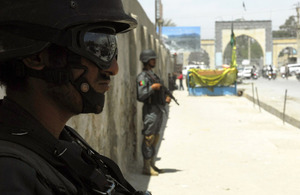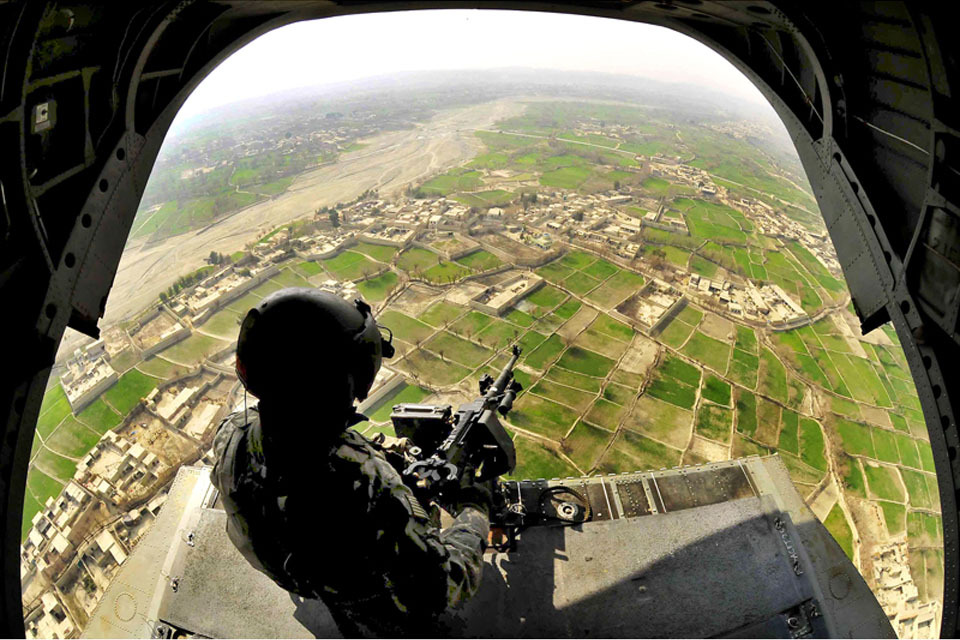Top British General speaks of progress in Kandahar
Major General Nick Carter, the Commander of Regional Command (South) in Afghanistan, has given an update on the progress of operations in Kandahar - the strategically important Afghan province adjacent to Helmand where the majority of British forces are based.

Afghan National Police on sentry duty at a marketplace in Kandahar City during a dismounted patrol [Picture: Courtesy of the United States Army]
Speaking to journalists via a video link from Afghanistan, Maj Gen Carter said that operations in Kandahar had been ongoing but that the nature of the problems in the province made it a ‘larger and more complex’ operation than Operation MOSHTARAK, which was carried out in Helmand earlier this year to purge several areas of insurgent influence:
The problem in Kandahar is different,” said Maj Gen Carter. “It straddles a huge city of between 500,000 and 700,000 people and five rural districts that wrap themselves around the city itself - the population therefore being plus of a million that we are managing.
And of course the problem is very different in terms of the politics in Kandahar and, like so much else in Afghanistan, it is not about war being an extension of politics by other means, it is much more about politics being an extension of war by other means.
Maj Gen Carter said that, therefore, many of the solutions to Kandahar lay in the political sphere as much as in military action.
He said that one of the biggest challenges was developing the agrarian economy that dominates the area by improving freedom of movement and enabling farmers to transport their goods to market. Securing the road network is, therefore, vital to progress in the province.
Maj Gen Carter said Highways 1 and 4 are two of the most strategically important routes in Kandahar, and the insurgency is trying to control Highway 1 as a way of combating the progress that the Afghan Government and ISAF are making.
Three phases have been developed in order to tackle the problem, which are presently running concurrently. The first is focused on Kandahar City, phase two was about the district of Arghandab to the north west, and phase three focuses on expanding operations into Senjaray and Panjva’i to the west:
The problem in Kandahar City I would characterise as very much like Moscow in the 1990s; it is very much about mobs, mafias. It is about protection rackets and it is about a very poor quality of order,” Maj Gen Carter said.
A feature of this lack of order is the lack of representation and Maj Gen Carter said a fundamental objective of what ISAF had been doing in the city was to connect the population to government:
We are trying to do that from the bottom upwards, because if we do it from the bottom upwards there is a sporting chance that the architecture I described in terms of patronage, power broking and protection rackets could really be defeated by the people themselves.
Maj Gen Carter said that security had to be enforced in tandem with this and in the last few months 12 security stations have been constructed around the outskirts of the city on the key access routes to provide a filter to make it difficult for the insurgency to move in and out of the city:
At each of these security stations freshly trained Afghan Civil Order Police in partnership with a US infantry battalion have been going about their business,” he said.
Not only have they been dealing with the routes though, they have been patrolling out with those security stations in order to make the connections with the local population.
But of course it is the development of the security, in-depth, inside the city which is also important and that is where a significant uplift in terms of US Army military policemen has been very important, because what we now have in the city is five times the number of military policemen that we had four months ago; five companies working in partnership with specially trained Afghan uniformed police.
While very successful security operations in the northern part of the city over recent weeks have knocked the insurgency back, Maj Gen Carter added that there is still a long way to go in the city as ‘governance will not be built overnight’.

Sergeant 1st Class James Lee provides aerial security from the rear door of a CH-47 Chinook helicopter over Kandahar province [Picture: Courtesy of the United States Army]
Outside the city, Afghan Government control of Arghandab is estimated by Maj Gen Carter to be in force over four-fifths of the city, whereas a few months ago that same fraction was considered to be under insurgent control.
The General said that success would largely be measured on the extent to which the district governor can move around freely and how much the population can move around freely.
The third phase of operations in Senjaray and Panjva’i has now been in play for six weeks or so and has involved a new US brigade that has been introduced into theatre over the last couple of months.
This new brigade has been partnered up with a new Afghan Army brigade along Highway 1 - just one part of a major uplift of ANA troops in the province:
The effect of that is that we probably now have an additional eight infantry battalions, or kandaks as the Afghans call them, based in Arghandab, Senjaray and Panjva’i.
All that resource that has been put together gives us a better chance now of securing the population, predominantly along Highway 1 but also in the populated areas of Panjva’i.
Maj Gen Carter also stressed that major efforts were underway to improve governance and political representation in the region.
Finally, he said that the provision of electricity had become a recurring theme during his time as commander in the region and there are now plans to double the generating capacity over the next few months, largely through diesel generators, with a view to solar and hydro power over the longer term.